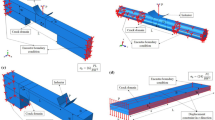Abstract
A single edge cracked geometry with clamped ends is well suited for fracture toughness and fatigue crack growth testing of composites and thin materials. Stress intensity factors may be determined by the weight function method. A weight function for the single edge cracked geometry with clamped ends is developed and verified in this paper. It is based on analytical forms for the reference stress intensity factor and crack mouth opening displacement. The analytical forms are shown to be valid, by comparison with finite element results, over a wide range of crack depths and plate aspect ratios. Use of the analytical form enables the weight function to be calculated for any plate aspect ratio without the need for preliminary finite element analysis. Stress intensity factors and crack mouth opening displacements, predicted using this weight function, correlated well with finite element results for non-uniform crack surface stress distributions.
Similar content being viewed by others
References
Ahmad, J., Papaspyropoulos, V. and Hopper, A.T. (1991). Elastic-plastic analysis of edge-notched panels subjected to fixed grip loading. Engineering Fracture Mechanics 38, 283-294.
Blatt, D., John, R. and Coker, D. (1994). Stress intensity factor and compliance solutions for a single edge notched specimen with clamped ends. Engineering Fracture Mechanics 47, 521-532.
Bowie, O.L., Freese, C.L. and Neal, D.M. (1973). Solution of plane problems of elasticity utilizing partitioning concepts. Journal of Applied Mechanics 40, 767-772.
Bueckner, H.F. (1970). A novel principle for the computation of stress intensity factors. Zeitschrift fur Angewandte Mathematik und Mechanik 50, 529-546.
Dao, T.X. and Mettu, S.R. (1991). Analysis of an edge cracked specimen subjected to rotationally constrained end displacement. NASA Report.JSC 32171 LESC 29683.
Fett, T., Mattheck, C. and Munz, D. (1987). Crack opening displacement from the stress intensity factor. Engineering Fracture Mechanics 27, 697-715.
Gambourne, M.L. (1990). Fatigue and fracture of titanium aluminides,WRDC-TR-89-4145, Materials Laboratory, Wright Patterson AFB, Ohio 45433-6533, USA.
Harris, D.O. (1969). Stress intensity factors for hollow circumferentially notched round bars. Journal of Basic Engineering 89, 529-546.
John, R. and Rigling, B. Effect of height to width ratio on K and CMOD solutions for a single edge cracked geometry with clamped ends. Engineering Fracture Mechanics.To be published.
John, R., Kaldon, S.G. and Ashbaugh, N.E. (1994). Applicability of fiber bridging models to describe crack growth in unidirectional titanium matrix composites. University of Dayton Research Institute, Dayton, Ohio, USA. UDR-TR-94-53.
John, R., Kaldon, S.G., Johnson, D.A. and Coker, D. (1995). Weight function for a single edge cracked geometry with clamped ends. International Journal of Fracture 72, 145-158.
Jones, I.S. and Lewis, M.W.J. (1996). An impulse response model for the prediction of thermal striping damage. Engineering Fracture Mechanics 55, 795-812.
Joseph, P.F. and Erdogan, F. (1989). Surface crack problems in plates. International Journal of Fracture 41, 105- 131.
Kaya, A.C. and Erdogan, F. (1980). Stress intensity factors and COD in an orthotropic strip. International Journal of Fracture 16(2), 171-190.
Kramb, V.A., John, R. and Ashbaugh, N.E. (1994). Ninth Annual Technical Conference, American Society for Composites, Technomic Publishing Co., Inc., Lancaster, Pennsylvania 17604, USA.
Marchand, N., Parks, D.M. and Pelloux, R.M. (1986). solutions for single edge notch specimens under fixed end displacements. International Journal of Fracture 31, 53-65.
Petroski, H.J. and Achenbach, J.D. (1978). Computation of the weight function from a stress intensity factor. Engineering Fracture Mechanics 10, 257-266.
Rice, J.R. (1972). Some remarks on elastic crack-tip stress fields. International Journal of Solids and Structures 8, 751-758.
Sharples, J.K. (1986). Stress intensity factor solutions for edge cracked plates loaded under displacement control. UKAEA Technical Report(1986) ND-R-1337(R), HM Stationery Office.
Tada, H., Paris, P.C. and Irwin, G.R. (1985). The Stress Analysis of Cracks Handbook, Del Research Corporation, St. Louis, Missouri, USA.
Waterloo Maple Inc., MAPLE V Release 4, Ontario, Canada.
Wu, X.R. and Carlsson, A.J. (1991). Weight Functions and Stress Intensity Factor Solutions, Pergamon Press, Inc., Elmsford, New York, USA.
Author information
Authors and Affiliations
Rights and permissions
About this article
Cite this article
Jones, I.S. A wide range weight function for a single edge cracked geometry with clamped ends. International Journal of Fracture 89, 1–18 (1998). https://doi.org/10.1023/A:1007463205924
Issue Date:
DOI: https://doi.org/10.1023/A:1007463205924



